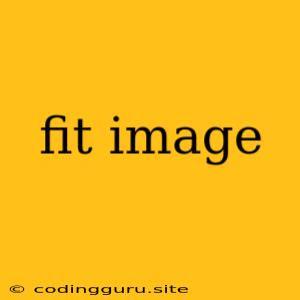Fitting Images Perfectly: A Comprehensive Guide
In the world of web development and design, image optimization is crucial for creating visually appealing and engaging experiences. A key aspect of image optimization is fitting images to the desired dimensions while maintaining quality. This process involves resizing, cropping, and sometimes even manipulating the image to achieve the perfect fit.
Why is Image Fitting Important?
Fit images for several reasons:
- Improved Loading Times: Smaller image sizes result in faster loading times, enhancing user experience and reducing bounce rates.
- Enhanced Aesthetics: Images that fit seamlessly within their designated spaces create a polished and professional look.
- Optimized Bandwidth Usage: Well-fitted images reduce bandwidth consumption, minimizing costs and ensuring smoother performance.
- Improved SEO: Search engines consider website loading speed as a ranking factor, making image optimization a vital aspect of SEO.
Techniques for Fitting Images
Here's a breakdown of common techniques to fit images effectively:
1. Resizing
- The Basics: Resizing involves changing the overall size of the image without altering its aspect ratio.
- When to Use: Use resizing when you want to shrink or enlarge an image while keeping its proportions intact.
- Tools: Most image editing software (like Photoshop, GIMP, or online tools) offer resizing options.
2. Cropping
- The Basics: Cropping removes unwanted portions of the image, allowing you to focus on the desired area.
- When to Use: Use cropping when you need to adjust the image's dimensions by removing parts while preserving its overall look.
- Tools: Image editors and online cropping tools facilitate easy cropping.
3. Aspect Ratio Considerations
- What is Aspect Ratio?: Aspect ratio is the ratio between an image's width and height. Maintaining the correct aspect ratio ensures the image appears proportional.
- Impact on Fit: Forcing an image to fit into a container with a different aspect ratio can result in distortion or unwanted cropping.
- Maintaining Proportions: Whenever possible, try to resize images while preserving their original aspect ratio for optimal results.
4. Responsive Image Techniques
- Adapting to Device Sizes: Websites need to adapt to different screen sizes, so fit images responsively.
- Using
<picture>Element: The<picture>element lets you define multiple image sources with varying dimensions, enabling the browser to choose the most appropriate image for the device. - Media Queries: Media queries allow you to apply different styles based on the screen size, enabling you to fit images seamlessly across devices.
5. Image Optimization Techniques
- Compression: Reducing the file size of an image without compromising quality can be achieved through compression techniques.
- File Formats: Consider using optimized file formats like WebP or JPEG 2000, which offer smaller file sizes while retaining image quality.
- Progressive Loading: Displaying a low-resolution version of an image first, then gradually loading the full-resolution image as it downloads, enhances the user experience.
6. CSS and Javascript for Image Fitting
- CSS
object-fitProperty: This CSS property provides options for fitting images within their containers, such as "cover," "contain," "fill," "scale-down," and "none." - Javascript Libraries: Frameworks like React, Vue.js, and Angular offer image manipulation libraries that can be used to resize, crop, or fit images dynamically.
Examples of Image Fitting in Different Frameworks
Here are examples of how to fit images using popular frameworks:
React
import React from 'react';
import { Image } from 'react-native';
const MyComponent = () => {
return (
This code snippet demonstrates using the resizeMode property to cover the container with the image, effectively fitting the image to the specified dimensions.
Next.js
import Image from 'next/image';
const MyComponent = () => {
return (
This code uses the next/image component with the layout="responsive" and objectFit="cover" props to ensure the image fits responsively within its container.
Vue.js
![My Image]()
This example uses the objectFit CSS property within the :style attribute to achieve a fit that covers the container.
Conclusion
Fitting images effectively is a fundamental aspect of web development and design. It contributes to improved loading times, visual aesthetics, and better user experience. Utilizing the techniques outlined above, developers can create visually appealing and optimized web pages. By mastering these techniques, you can create a seamless and compelling online experience for your users.
